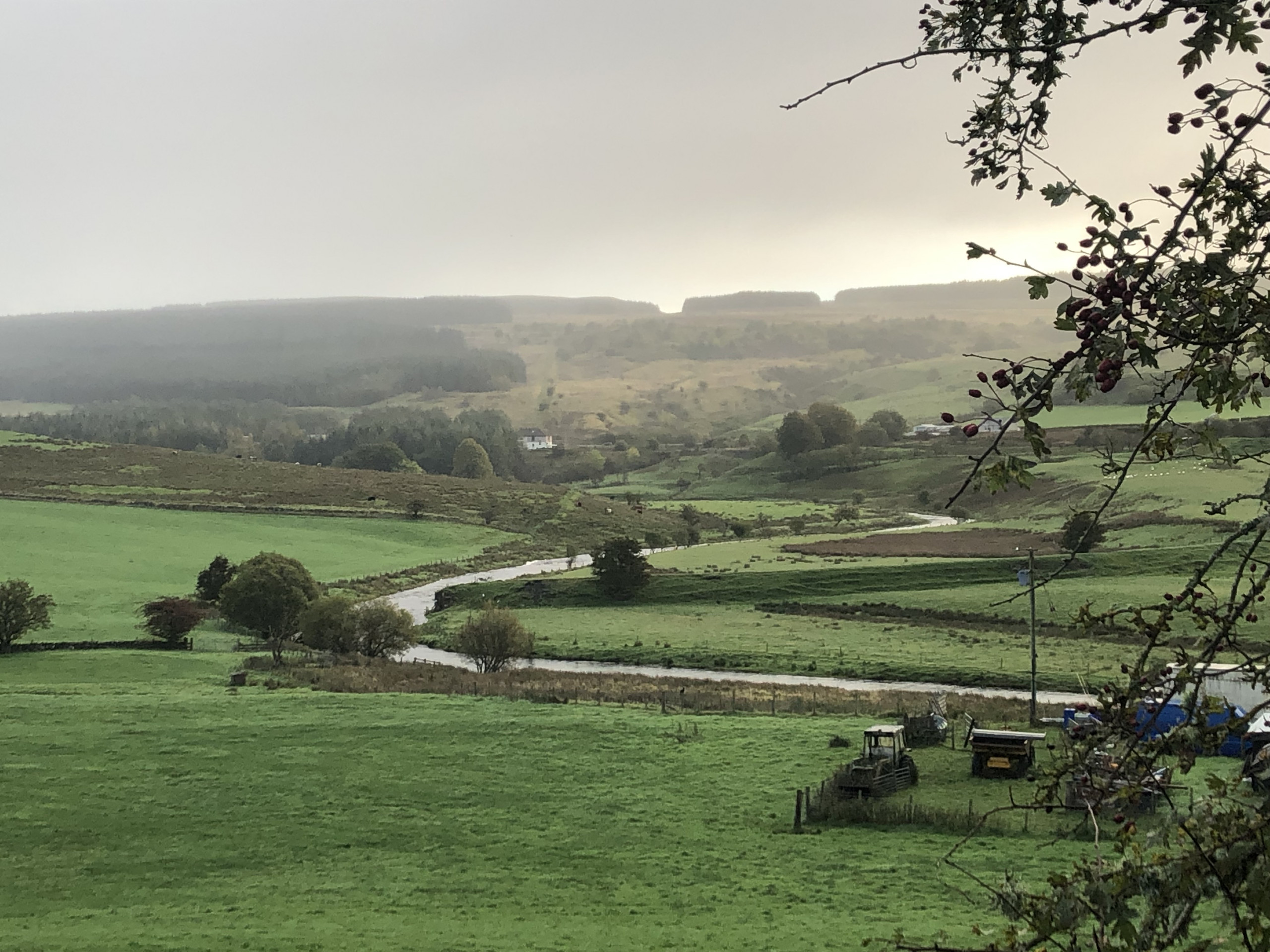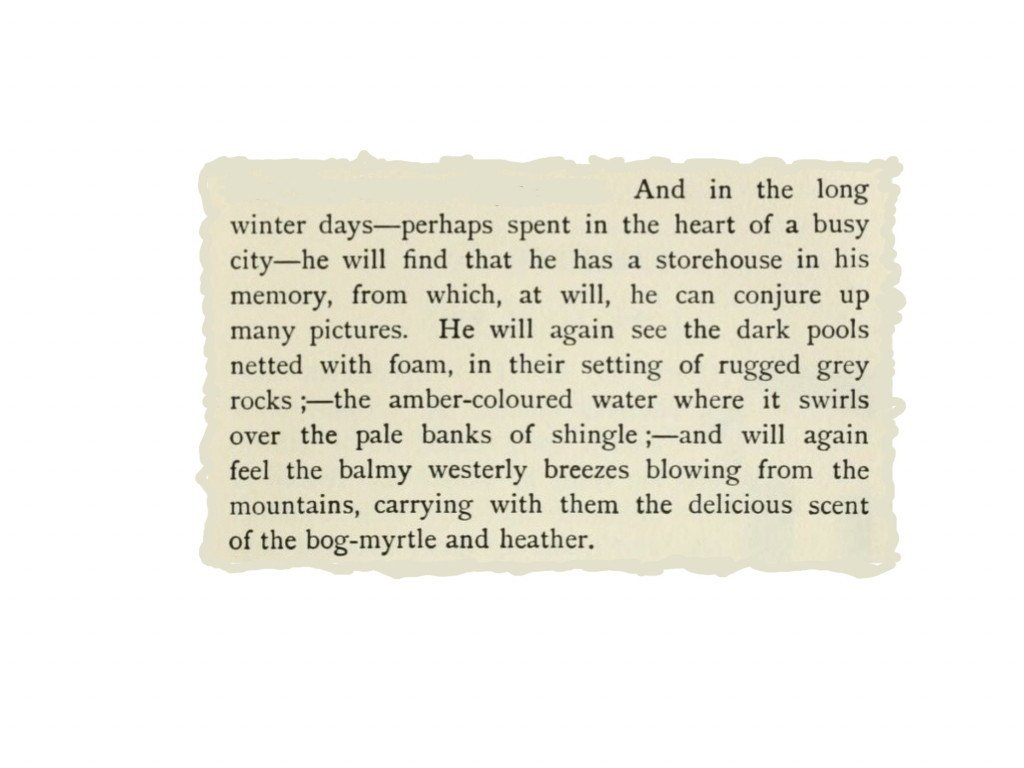

Looking down to the right from the road to Carnochan Farm

Carnochan Farm at ‘The End of the Rainbow’

Back to the Fishing Hut at the End of the Day


“A day or a week on the Smithston Water is a joy, whether because the salmon are running or simply from the joy of being in a beautiful place.”
DIRECTIONS
To find us, turn west off the the A713 (between Castle Douglas and Ayr) in the village of Patna across the Doon Bridge. Meander along Main Street until the road rises and curls left, and you take a right turn at the War Memorial on a road between the two cemeteries. The road dips down and narrows with light woodland, hazel coppice and rough pasture to the left and, as you break out the trees, grassy slopes down to the River Doon (and the Top ‘A’ Beat) to the right.
You pass a small grassy lay-by on the left – a convenient parking place for fishing the Top ‘A’ Beat – and onward to a junction (right to Carnochan Farm and left to Shankston Farm). Take the right turn and follow the road downhill to Carnochan Farm. Through the farmyard, you leave the farmhouse on your left and follow your nose to a five-barred gate leading left into a meadow pasture. There are generally livestock in the fields so please shut the gate promptly once you have passed. Follow the track that follows the course of the river, down to your right, for about 500 metres, until you find our Cabin, set in the western corner of the field, within its own gated enclosure.
THE DAY
Arrival time at the Cabin is recommended at between 8.30am & 8.45am on the first day of fishing. Should an angler be unlikely or unable to be at the fishery at the start of their first day, it would be appreciated if he/she would advise the Committee accordingly.
Each rod-day (for all anglers, whether members or visitors) is allocated to a particular combination of morning and afternoon beats; either A/B, or B/C, or C/A, with the changeover from ‘morning’ to ‘afternoon’ beats at 1300. On the next day, anglers start by fishing the same beat as for the preceding afternoon, then rotating to the next beat at 1300…..and so on, day by day.
Members will be aware of what their beat rotation schedule is, in advance. Visitor Permit anglers will be able to see what beat allocation options are available, as part of the pre-booking and booking processes
An angler who arrives to fish, after the Monday simply ‘picks up’ the relevant position on the beat rota for that day. Notwithstanding this structure, anglers fishing on any day may choose to vary the beat allocation by mutual consent, particularly if the fishery is not fully ‘rodded’ on that day. Whilst there is no formal “starting time” for each day’s fishing, when two anglers are sharing a beat it is sensible for them to liaise over starting times, and how they want to share the pools; (for example, one angler might start at the top of the beat, and the other halfway down, etc.)
Please take a moment to read the Club Rules and Risk Assessment (which are under the ‘Club’ dropdown menu on this website) and are pinned up in the Cabin. Both are relatively brief.
We change beats at 1.00pm (A to B, B to C and C to A) and many stop for lunch then too. While some will call it a day by 5.00pm or so, others fish in the evening, and visitors are most welcome to do so. In discussion with other anglers, the Cabin must be left secure and left tidy for the next day, and must be locked at all times if no one is present during the day. Any catches should be recorded to the Club email if possible () or in the Game Book in the Cabin (size of fish, fly or lure and pool) along with a record of the fishing effort/hours and any other happenings of note. Please also leave a note if you find anything that demands the attention of the River Keeper.
Fishermen are most welcome to use the barbecue by the Cabin and are asked to leave it all clean and tidy at the close. A family gathering, on the river, on a fine evening, at the end of a day’s fishing is just wonderful.
A ghillie is not provided as a rule but anglers may make their own arrangements or set an appointment with our River Keeper for a brief on the beats and the river more generally. If fishing alone, you may wish to advise someone of your expected start and finish times on the river in case of any unexpected issue. Mobile phone signal is generally reasonable on most of the Smithston beats (Bottom beat less so).
TACKLE & TECHNIQUE
Smithston fishes the fly well along its whole length, and at most heights as the water clears quickly after a spate. Due to the compensation flow, the river will fish fly well still after others have dropped to lower and slower levels.
For fly fishing, either a single handed rod of 10-11′ (in lower water) or double handed rod 12-13′ (higher water) will suffice. The Doon is not a big river, but some of the salmon can be, and river is powerful in places. Therefore a leader strength of at least 10lb is recommended, and probably 12-15lb in higher water.
A floating or intermediate line will be sufficient, although a sink tip will help in a bigger water. Flies in sizes 8-12 will generally suffice, or tube flies of 0.5-1″; a copper tube is often successful in the autumn or in a bigger water. Favoured patterns are the usual; Cascade, Ally’s Shrimp, Willie Gunn, Oykel GP etc. For Tube flies, Red Devil and Freddie’s Orange are also favoured.
In the warmer days of summer, fishing early or late can bring success, once the sun is off the water. Small flies down to size 14 or even 16 doubles fished in the faster water may tempt a grilse – think like a trout fisherman. A Silver Stoat or Stoats Tail can be worth a try, and a dropper fly too perhaps.
When spinning is permitted, the floating Rapala is favoured by most, in various colours and sizes, with orange or zebra for a coloured water, and black and silver or gold doing well as the water clears.
In common with many rivers, the pool tails fish well in a higher water, and always fish these right to the end….you may find that the ‘stone’ you have hooked is in fact a salmon! Conversely, when the river is down at compensation level, the fast water at pool necks and little ‘pots’ between pools are worth focusing on.
Most of the river can be fished easily without any wading, although in lower water, wading in above the pool neck may be helpful in some places. In high water, wading is discouraged and may be dangerous in places. A wading stick is highly recommended due to the fast current and uneven river bed.
Visitors should not hesitate to ask Club Members for advice if unsure.
“Tight Lines!”